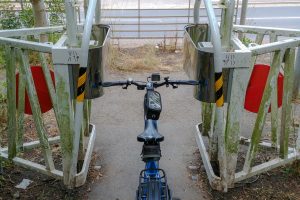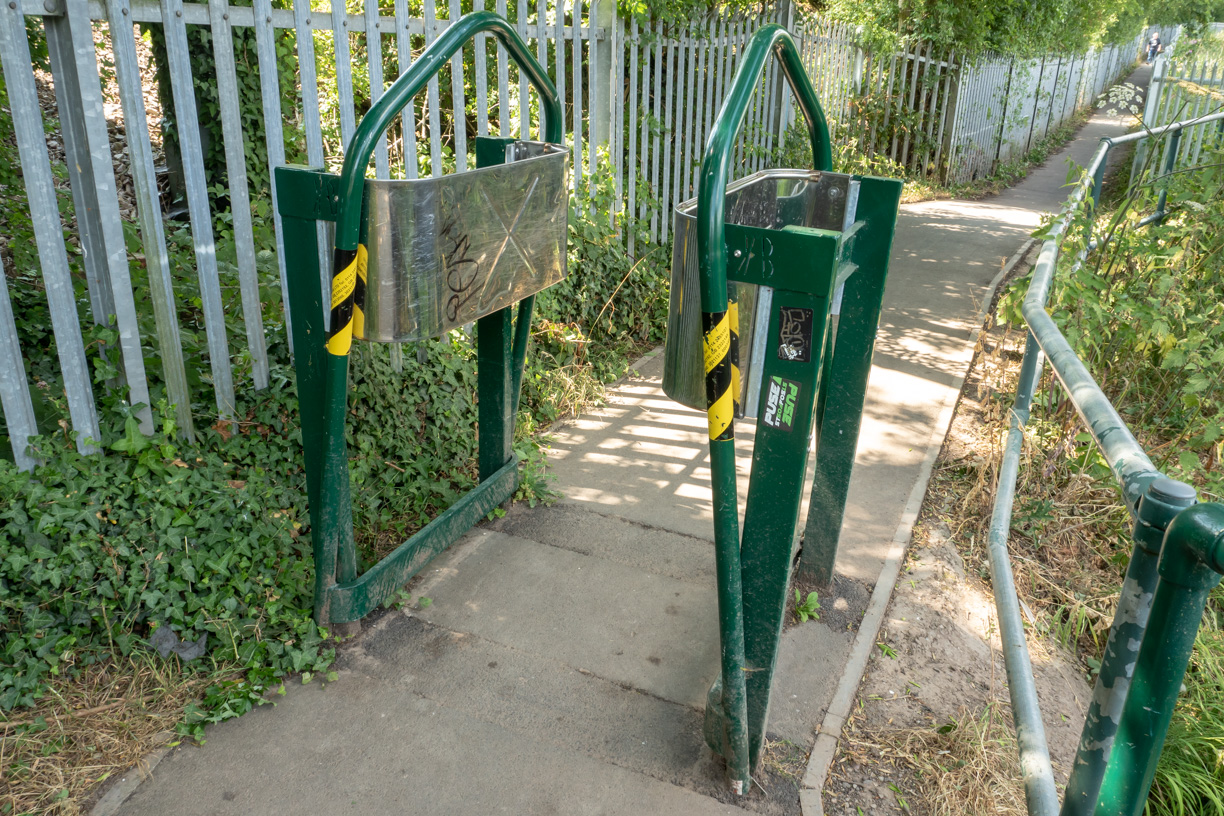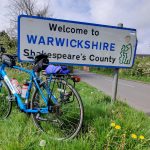K-Frame Barriers on NCN52 (Weddington Walk)
This website is made available free of charge and without adverts. While it's not here to make money, it does have costs. If you can throw a few pounds my way to help out, your support is gratefully received! Thank you!

There’s a generally rather nice section of National Cycle Network (NCN) route 52 as it leaves Nuneaton called Weddington Walk. This is an off-road shared path running along the route of an old railway line, heading up to the A5. I say generally nice, because whilst it’s reasonably wide, mostly quiet and properly surfaced with tarmac, it is hindered by K-Frame barriers at a number of access points.
These barriers exist to prevent access to the route by motorbikes and on the surface, that seems like a reasonable aim. After all, cyclists and pedestrians do not want to be put at risk by the illegal use of an off-road route by motor vehicles. However, by using them, not only does it achieve the stated aim, but at best they also puts a hindrance in place for valid road users – at worse, they deny them access.


The handlebars on my bike aren’t especially wide, but my access to the route is impacted by the presence of these barriers. They mean that I have no choice but to dismount and contort the bike through them. I am fortunate in that I can do that, although I would be worried about doing so if I were carrying a child on a properly installed child-seat over the pannier rack as this can make a bicycle very unstable when being pushed rather than ridden. But if I had, say, a heavy bike, cargo bike or trailer, getting through here may be next to impossible.
Perhaps more importantly though is the impact on disabled and less able people who have just as much right to use the route as anyone else. However, navigation by non-standard bikes, tricycles, quad-cycles, hand-cycles or other form of cycle modified to accommodate a disability plus certain wheelchairs and mobility scooters may be difficult or even impossible. Then there are the cyclists who can ride well on a ‘standard’ bicycle but are maybe unstable on foot and could be unsteady moving their cycle through the narrow gap.
I decided to send a tweet on this, in which I tagged Nuneaton and Bedworth Council. This was kindly put to the Parks Department within the Council and I soon had a brief response:
National Cycle Network NCN52 – great for cycling, as long as you don't mind getting off and contorting the bike through barriers. And if you physically can't, well tough luck. @NBBCouncil – please remove these discriminatory, unnecessary obstructions on Weddington Walk. pic.twitter.com/ajsuiVWHgd
— Bicycle Ben ??? (@BicycleBenUK) July 7, 2018
The barriers are designed to do exactly what is happening: make riders stop and manoeuvre their way through. It is to deter motorcyclists from being able to race through without stopping. They are designed to meet the necessary standards and are used extensively across the UK
— Nuneaton&BedworthBC (@NBBCouncil) July 10, 2018
So, Nuneaton Council have confirmed the purpose of the barriers and also state they meet necessary standards. They also make an unnecessary comment about their use across the UK – unnecessary since just because something is prevalent, it doesn’t mean that it’s right.
I responded to this asking how these gates provide non-discriminatory and equal access to users of non-standard cycles or who have mobility issues. Unfortunately their reply didn’t come through Twitter this time; the response from the Parks Department was too long for Twitter’s 280 character limit. So, I gave them my email address and I received their reply.
Paraphrasing their response, the Council stated they have no legal obligation to ensure that able-bodied users can access the route unhindered. They said that they are aware of the problems barriers cause and don’t install them lightly but due to a problem of motorcycles accessing the route, they had to make the decision to inconvenience valid users to keep them safe. Of particular interest was their comment that legislation does not require them to accommodate larger mobility scooters, and that if someone with disabilities has issues, then they will review what is put in place. Further, they noted that taking no action to remedy a known hazard would leave the Council liable in the event of an incident leading to injury or death, and also would result in negative public opinion.

I’m not altogether surprised by this response, but it is disappointing. It seems to suggest that no equality assessment has been conducted before using these barriers (by virtue that they suggest they will be reactive to complaints about disability issues rather than proactive to prevent such issues arising in the first place.) It is also interesting that they suggest they have no obligation to accommodate larger mobility scooters, which I would suggest by extension would also included larger wheelchairs or electric wheelchairs and other larger mobility aids (perhaps tricycles or hand-cycles). There is also no suggestion of any impact or risk assessments being conducted with regard to, for example, the risks encountered by any cyclist carrying a child on a properly fitted child-seat or other heavy load – as already noted above, bikes can be very unstable when pushed in this situation and maneuvering through narrow barriers may present a risk of toppling.
I have therefore responded to the Council with a series of questions to be considered under the Freedom of Information Act, to determine whether a proper evaluation has been conducted, including the consideration of other means of deterring illegal motorcycle use:
- Please provide details of the nature and number of complaints that have been raised from any source in respect of motorcycle use of this path, broken down by year, since its inception to the present day. Please provide the same for Sandon Park as a whole covering the same time period.
- Please provide a copy of any Council cycle strategy or policy regarding encouraging active travel.
- Please detail what design standards guidance were referred to when evaluating measures to restrict access to Weddington Walk and elsewhere, for example (but not limited to) the Sustrans guidance “Traffic Free Routes: Conceptual Design“, Sustrans guidance “Access Control Guide“.
- Please explain how the use of the barriers in place on Weddington Walk complies with any consulted design guidance.
- What other measures were considered before K-frames were decided upon? Were other methods (e.g., CCTV; intelligence-led operations in conjunction with the police) considered, tested and evaluated? If so, why were these methods ultimately discounted? If this was not done, why not?
- Do council officers routinely consult with Sustrans (who manage the National Cycle Network) or any disability advocacy groups (such as Wheels for Wellbeing) regarding the installation of access controls? Did they do so in the specific case of Weddington Walk and the K-frame barriers?
- Please provide details of any assessments conducted by council officers in regard to the Council’s obligations under The Equality Act 2010 with respect to disabled people and the installation of access control and ultimately the K-frame barriers. Please also detail the assessments conducted around the needs of users operating non-standard cycles, cycles carrying/towing loads (e.g., child seats, heavily loaded on-cycle bags, cargo bikes, trailers etc.), tricycles and other heavy cycles that may be difficult to lift or manoeuvre.
- You have stated that if the route remained completely open following complaints of motorcycle activity, you would be liable for inaction for not trying to address it. Please provide a source for this liability (e.g., legislation, previous legal action). Please explain why ‘trying to address a known and significant hazard’ means the installation of barriers, rather than any other options.
- You state that larger mobility scooters are not covered by legislation. Please explain, in light of the Equality Act 2010, how large mobility scooters (and presumably by extension larger wheelchairs, electric wheelchairs and modified cycles including tricycles and handcycles) are excluded from your obligations.
Under the Freedom of Information Act, the Council has twenty days to respond. I’ve noted that I intend to publish their response so, when it comes through, I’ll publish a new post.







2 thoughts on “K-Frame Barriers on NCN52 (Weddington Walk)”
Comments are closed.